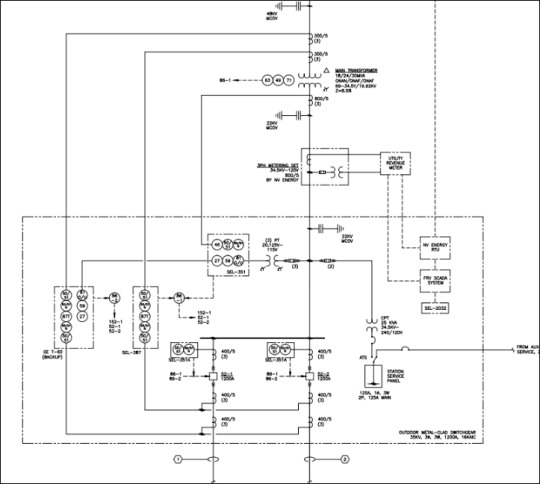#coordinationstudy
Explore tagged Tumblr posts
Text
⚡💼 Protection relays have been crucial in ensuring reliable and safe operation in electrical power systems. To ensure best practices, let's explore key guidelines!
1️⃣ System Planning and Coordination: Adequate planning and coordination improve fault detection and isolation. #PowerSystemPlanning #CoordinationStudy
2️⃣ Equipment Selection and Application: Ensure suitable protective devices for different system equipment to detect faults effectively. #ProtectiveDevices #FaultDetection
3️⃣ Risk Assessment and Fault Analysis: Analyze potential hazards, fault currents, and locations for designing proper protection schemes. #RiskAssessment #FaultAnalysis
4️⃣ Redundancy and Backup Protection: Incorporate alternate paths for power flow during faults or primary protection device failure. #Redundancy #BackupProtection
5️⃣ Reliability Testing and Maintenance: Regularly test and maintain protective relays to verify correct operation and reliability. #ReliabilityTesting #MaintenanceBestPractices
6️⃣ Cybersecurity Measures: Protect communication networks, data confidentiality, and secure remote access to protection devices. #Cybersecurity #ProtectiveDevices
7️⃣ Training and Documentation: Comprehensive training and proper documentation enhance efficient management and facilitate modifications. #Training #Documentation
8️⃣ Continuous Monitoring and Condition Monitoring: Deploy real-time monitoring systems for early fault detection and preventive maintenance. #ContinuousMonitoring #ConditionMonitoring
📜 Standard Recommendation: The IEC 61850 standard provides guidelines for protection, control, and automation in power systems. #IEC61850
Remember, safety should always be prioritized in any protection strategy to safeguard personnel, equipment, and the environment.
Join the discussion by sharing your experiences and insights on power systems protection! 💬⚙️ #PowerSystemsProtection #SafetyFirst
0 notes
Text
Coordination study | vggsystems.com

EV Charging Station Integration - Expert witness litigation, professional engineer, pole loading calculation ocalc, microgrids in san Francisco, electrical studies arc flash and solar companies in bay area
coordination study
0 notes
Text
Unraveling the Importance of Coordination Studies in Distribution Systems & Software Options for Analysis
Greetings, distinguished readers! Now, let us unravel the significance of coordination studies in distribution systems. We shall take a closer look at their purpose, key considerations, and the role they play in ensuring the safe and reliable operation of electrical distribution networks. Additionally, we will explore a few commonly used software options for performing coordination studies.
Coordination studies are a critical aspect of electrical system design, focusing on the selection and coordination of protective devices such as fuses, circuit breakers, and relays. The primary objective is to achieve selective and timely isolation of faults while minimizing equipment damage and optimizing system reliability.
Key considerations in coordination studies for distribution systems include:
1. Equipment Rating and Characteristics: A thorough understanding of the rating and characteristics of the protective devices and associated equipment is essential. It involves evaluating factors such as current-carrying capacity, interrupting capabilities, time-current curves, and coordination limits.
2. Fault Types and Analysis: Accurate analysis of different fault types and their potential locations within the distribution system is crucial. Common fault types include short circuits, overloads, and ground faults. By studying fault scenarios, engineers can determine the appropriate coordination settings for protective devices.
3. Time-Current Coordination: Achieving proper time-current coordination is paramount to ensure selective fault clearing. This involves setting different device trip times based on the magnitude and duration of the fault currents. The coordination curve plots these device characteristics and ensures that only the closest upstream protective device operates during a fault, isolating the affected section while maintaining system integrity.
While ETAP is a popular software used for coordination studies in distribution systems, there are other options available as well. Here are a few commonly used software programs for coordination studies:
1. SKM PowerTools: A comprehensive software suite offering a range of analysis modules, including coordination studies.
2. EasyPower: Widely used software for analyzing and coordinating protective devices in electrical systems, with features such as arc flash analysis and comprehensive coordination settings.
3. CYME International T&D: Software modules like CYME GRIDS and CYME DAPPER for performing coordination studies in distribution systems, helping engineers analyze fault currents and evaluate protection device settings.
4. PTW Electrical Software: Designed by Integrated Engineering Software (IES) for power system analysis and design, including coordination studies, fault analysis, and load flow analysis.
5. DigSilent PowerFactory: A powerful software used for electrical network analysis and simulation, providing capabilities for coordination studies, protection device modeling, and evaluating fault scenarios.
These software programs offer unique features and capabilities to aid engineers in conducting efficient coordination studies. It's important to assess your specific requirements before choosing the most suitable option for your needs.
#CoordinationStudies #DistributionSystems #ElectricalDesign #ProtectiveDevices #SystemReliability #FaultAnalysis #TimeCurrentCoordination #ElectricalEngineering #SoftwareOptions
0 notes